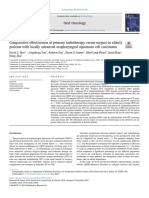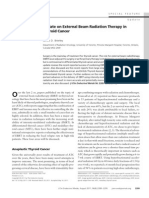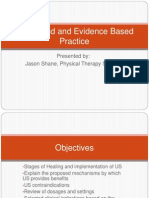Oncology Care
Oncology Care
Uploaded by
Quennie Abellon QuimanCopyright:
Available Formats
Oncology Care
Oncology Care
Uploaded by
Quennie Abellon QuimanOriginal Description:
Copyright
Available Formats
Share this document
Did you find this document useful?
Is this content inappropriate?
Copyright:
Available Formats
Oncology Care
Oncology Care
Uploaded by
Quennie Abellon QuimanCopyright:
Available Formats
JOURNAL SNAPSHOT
An Assortment of Journal Abstracts to
Enhance Oncology Care
G
iven the abundance of new research, it can be challenging to stay logistic regression, patients who went to hospice or post-acute care were
current on the latest advancements and findings. Oncology Times older, lived alone, and had impaired mobility compared to patients who
is here to help with summaries of the newest studies to ensure were discharged home. Additionally, they experienced longer hospital
you are up-to-date on the latest innovations in oncology practice. stays, as well as higher scores for physical outcomes and depression.
Given these results, researchers concluded that “these patients may ben-
Whole-genome sequencing reveals breast cancers with mismatch efit from interventions to enhance their quality of life and care.”
repair deficiency
Mutational signature analysis found mismatch repair (MMR)-deficient Endothelial activation and blood-brain barrier disruption in
breast cancer tumors, which could potentially be targeted with PD-1 neurotoxicity after adoptive immunotherapy with CD19 CAR-T cells
immune checkpoint inhibitors, according to a recently published study Researchers have discovered new potential biomarkers and a novel al-
(Can Res 2017; doi:10.1158/0008-5472.CAN-17-1083). Researchers gorithm that could help identify patients at increased risk of suffer-
used previously published whole genome sequencing data of ing from severe neurotoxicity after receiving CD19 CAR T-cell therapy
Breast Cancer
breast cancer tumors from 640 patients and analyzed patterns of (Can Discov 2017; doi:10.1158/2159-8290.CD-17-0698). Researchers
mutagenesis. They also looked for mutations in multiple genes analyzed data from 133 adults with relapsed and/or refractory
CAR T-Cell Therapy
known to be associated with MMR deficiency: MLH1, MSH2, CD19 B-cell ALL, non-Hodgkin lymphoma, or chronic lympho-
MSH6, PMS2, PMS1, SETD2, MYH11, EPCAM, TGFBR2, MLH3, cytic leukemia who were treated with lymphodepletion chemo-
and MUTYH, in order to identify the defects responsible for the therapy followed by infusion of JCAR014, a type of CD19 CAR
MMR deficiency. Findings showed that 11 of 640 tumors har- T-cell therapy. Within 28 days of treatment, 53 patients (40%) de-
bored the MMR deficiency in variable amounts. In addition veloped grade 1 or higher neurologic adverse events and of these
to base substitution mutational signatures specific to MMR- 28 (21%) had grade 3 or higher neurotoxicity; alterations in neu-
deficient tumors, they also found an average of 20,870 small in- rologic status completely resolved in a majority of cases. Four of
sertions/deletions in the 11 MMR-deficient breast cancer tumors the 133 patients (3%) developed fatal neurotoxicity. Investigators
compared to only a fraction, 270 on average, in the non-MMR-deficient found that patients with an early onset of cytokine release syn-
tumors. Due to its high degree of sensitivity and specificity to classify drome were at increased risk of subsequently developing severe
tumors, mutational signature analysis might be a better biomarker for neurotoxicity. According to researchers, patients who experienced
use in future clinical trials, according to study authors. neurotoxicity were mostly younger and had B-cell ALL, higher
tumor burden, and more CD19-positive cells in the bone marrow com-
Association of alterations in main driver genes with outcomes of pared with those who did not develop this side effect. Researchers devel-
patients with resected pancreatic ductal adenocarcinoma oped a predictive classification tree algorithm based on the side effects,
Alterations in four main genes are responsible for how long patients including fever, and high serum IL-6 and MCP-1, to identify patients
survive with pancreatic cancer, according to a new study (JAMA within the first 36 hours after CAR T-cell infusion, who are at increased
Oncol 2017; doi:10.1001/jamaoncol.2017.3420). The study included risk for severe neurotoxicity.
356 patients with resected pancreatic adenocarcinoma. After
Pancreatic Cancer
the tumors were removed, scientists extracted DNA from the Delay in radiotherapy is associated with an increased risk of disease
cancerous tissue and nearby normal tissue, and conducted next- recurrence in women with ductal carcinoma in situ
generation DNA sequencing on the specimens. The analysis cen- New findings suggest delaying radiotherapy by more than 12 weeks
tered on the activity of the KRAS, CDKN2A, SMAD4, and TP53 is associated with an increased risk for ipsilateral breast tumor recur-
genes. Results showed that patients who had three or four of the rence among women who underwent breast-conserving surgery
altered genes had worse disease-free survival and overall sur- for ductal carcinoma in situ (DCIS) (Cancer 2017; doi:10.1002/
Ductal Carcinoma in Situ
vival (OS) compared to patients with one or two altered genes. cncr.30972). A prospectively maintained database was utilized
Five-year OS was 18.4 percent for patients with 0-2 gene altera- to identify women (n=1,323) with DCIS who underwent breast-
tions, 14.1 percent for individuals with three alterations, and 8.2 conserving surgery and radiotherapy between 1980 and 2010.
percent for those with four alterations, investigators reported. Investigators compared recurrence rates among patients who
Pancreatic cancer is aggressive and generally has poor survival began radiotherapy less than 8 weeks after surgery, 8-12 weeks
odds. Patients who can undergo surgery as part of treatment after, and more than 12 weeks after surgery to evaluate the asso-
often survive longer, and some patients fare best when they can receive ciation between timing of radiotherapy and recurrence. Median
chemotherapy prior to surgery. “But having customized, molecular follow-up was 6.6 years and 311 patients were followed for 10
information will provide an even greater understanding of how the or more years. Researchers categorized patients by radiotherapy
disease is likely to progress in each patient,” researchers noted. timing with most patients (61%; n=806) receiving radiotherapy
within 8 weeks of surgery. Twenty-nine percent (n=386) received
Predictors of posthospital transitions of care in patients with radiotherapy at 8-12 weeks and 10 percent (n=131) at more than
advanced cancer 12 weeks after surgery. The 5- and 10-year recurrence rates were
Recent findings show patients with advanced cancer who are dis- 5.8 percent and 13.0 percent, respectively, for patients who started
charged to post-acute or hospice care demonstrated greater symptom radiotherapy fewer than 8 weeks after surgery; 3.8 percent and
burdens and impaired physical function, in addition to worse 7.6 percent, respectively, for radiotherapy starting between 8-12 weeks
Post-Acute Care
survival, than those discharged to the home (J Clin Oncol 2017; after surgery; and 8.8 percent and 23.0 percent, respectively, for a ra-
doi:10.1200/JCO.2017.74.0340). A prospective study was con- diotherapy delay of greater than 12 weeks after surgery (P = .004). OT
ducted among 932 patients with advanced cancer who had un-
planned hospitalizations between September 2014 and March
2016. The primary outcome was discharge location and the sec- Share New Research!
ondary outcome was survival. Among the enrolled patients, the Is there a study you think your fellow oncologists
majority (77.9%; n=726) were discharged home without hospice, should know about? Send new and innovative
while 12.7 percent (n=118) were discharged to post-acute care,
research to pam.tarapchak@wolterskluwer.com
and 9.4 percent (n=88) were discharged to hospice. According to
oncology-times.com Oncology Times 25
You might also like
- 2007 - Orthodontics and MicroimplantsDocument356 pages2007 - Orthodontics and MicroimplantsInês FerreiraNo ratings yet
- New Month Prayer PointsDocument4 pagesNew Month Prayer PointsQuennie Abellon Quiman100% (6)
- 40 Prayer Points For A New BeginningDocument4 pages40 Prayer Points For A New BeginningQuennie Abellon Quiman94% (16)
- CPG On Chronic CoughDocument93 pagesCPG On Chronic Coughgail100% (2)
- Obst 8 - All Obstetrics 4 2021Document28 pagesObst 8 - All Obstetrics 4 2021Menna KamalNo ratings yet
- Ethics Case StudyDocument9 pagesEthics Case Studyapi-305128971100% (1)
- Bristow 2002Document12 pagesBristow 2002Lưu Chính HữuNo ratings yet
- Does The Timing of Surgery After Neoadjuvant Therapy in Breast Cancer Patients Affect The Outcome?Document6 pagesDoes The Timing of Surgery After Neoadjuvant Therapy in Breast Cancer Patients Affect The Outcome?Pani lookyeeNo ratings yet
- ANZ Journal of Surgery - 2021 - Yang - Outcomes of Patients With Metastatic Cutaneous Squamous Cell Carcinoma To The Axilla PDFDocument8 pagesANZ Journal of Surgery - 2021 - Yang - Outcomes of Patients With Metastatic Cutaneous Squamous Cell Carcinoma To The Axilla PDFRong LiuNo ratings yet
- Glandula SalivarDocument8 pagesGlandula SalivarporsanimedNo ratings yet
- JCO 2003 Lin 631 7Document7 pagesJCO 2003 Lin 631 7Adhika Manggala DharmaNo ratings yet
- Esophageal Cancer Recurrence Patterns and Implicati 2013 Journal of ThoracicDocument5 pagesEsophageal Cancer Recurrence Patterns and Implicati 2013 Journal of ThoracicFlorin AchimNo ratings yet
- Neoadjuvant Paclitaxel For Operable Breast Cancer: Multicenter Phase II Trial With Clinical OutcomesDocument6 pagesNeoadjuvant Paclitaxel For Operable Breast Cancer: Multicenter Phase II Trial With Clinical OutcomesSubhash SugathanNo ratings yet
- Me Hanna 2016Document11 pagesMe Hanna 2016eswarNo ratings yet
- Detection of Recurrent Oral Squamous Cell Carcinoma by (F) - 2-Fluorodeoxyglucose-Positron Emission TomographyDocument9 pagesDetection of Recurrent Oral Squamous Cell Carcinoma by (F) - 2-Fluorodeoxyglucose-Positron Emission TomographyMindaugas TNo ratings yet
- Pi Is 1556086416310723Document9 pagesPi Is 1556086416310723hafidisara05No ratings yet
- TNBC PMRTDocument7 pagesTNBC PMRTMed MedNo ratings yet
- Surgical Delay and Pathological Outcomes For Clinically Localized High Risk Prostate Cancer PDFDocument11 pagesSurgical Delay and Pathological Outcomes For Clinically Localized High Risk Prostate Cancer PDFMuhammad RifkiNo ratings yet
- Ournal of Linical Ncology: PurposeDocument7 pagesOurnal of Linical Ncology: PurposeIvor Wiguna Hartanto WilopoNo ratings yet
- Ni Hms 519602Document21 pagesNi Hms 519602Nur Rissa MaharanyNo ratings yet
- Conventional Dose ChemotherapyDocument8 pagesConventional Dose ChemotherapyOnic AugustineNo ratings yet
- Tca 12 2161Document9 pagesTca 12 2161hafidisara05No ratings yet
- RescateDocument9 pagesRescateLorena Sánchez PérezNo ratings yet
- Contemporary Management of Advanced Laryngeal CancDocument3 pagesContemporary Management of Advanced Laryngeal Cancandre halimNo ratings yet
- 2021 Consolidation Theraphy in Esophageal CancerDocument6 pages2021 Consolidation Theraphy in Esophageal CancerykommNo ratings yet
- Eddy 2007Document8 pagesEddy 2007Mimsy Quiñones TafurNo ratings yet
- Neoadjuvant Treatment For Newly Diagnosed Advanced Ovarian Cancer. 2020Document9 pagesNeoadjuvant Treatment For Newly Diagnosed Advanced Ovarian Cancer. 2020Prodromos KoutoukoglouNo ratings yet
- Kapiteijn 2001Document9 pagesKapiteijn 2001cusom34No ratings yet
- Cancer - 2002 - Hendry - Metastatic Nonseminomatous Germ Cell Tumors of The TestisDocument9 pagesCancer - 2002 - Hendry - Metastatic Nonseminomatous Germ Cell Tumors of The TestisBrilliantNo ratings yet
- Extracranial ChondrosarcomaDocument8 pagesExtracranial ChondrosarcomaSyedNo ratings yet
- COGNITION A Prospective Precision Oncology TrialDocument12 pagesCOGNITION A Prospective Precision Oncology Trialveaceslav coscodanNo ratings yet
- 基于SEER数据库的4期胰腺癌手术治疗获益分析Document16 pages基于SEER数据库的4期胰腺癌手术治疗获益分析gen linlinNo ratings yet
- Annals Case Reports PDF Final Final.25.05.l22.Document13 pagesAnnals Case Reports PDF Final Final.25.05.l22.rossbar13No ratings yet
- Prognostic Model For Survival of Local Recurrent Nasopharyngeal Carcinoma With Intensity-Modulated RadiotherapyDocument7 pagesPrognostic Model For Survival of Local Recurrent Nasopharyngeal Carcinoma With Intensity-Modulated Radiotherapypp kabsemarangNo ratings yet
- Theraphy RadDocument4 pagesTheraphy RadMega PuspitaNo ratings yet
- Medullary Thyroid Cancer in The Era of Tyrosine Kinase Inhibitors: To Treat or Not To Treat-And With Which Drug-Those Are The QuestionsDocument7 pagesMedullary Thyroid Cancer in The Era of Tyrosine Kinase Inhibitors: To Treat or Not To Treat-And With Which Drug-Those Are The QuestionsIulia JulyNo ratings yet
- MeduloblastomaDocument7 pagesMeduloblastomasilvia erfanNo ratings yet
- Local Recurrence After Breast-Conserving Surgery and RadiotherapyDocument6 pagesLocal Recurrence After Breast-Conserving Surgery and RadiotherapyLizeth Rios ZamoraNo ratings yet
- MÁS RADIOTERAPIA SI RECAÍDA y Biopsia A Todos. 310 PersonasDocument13 pagesMÁS RADIOTERAPIA SI RECAÍDA y Biopsia A Todos. 310 Personasouf81No ratings yet
- Cross Trial - Preoperative Chemoradiotherapy For Esophageal or Junctional Cancer - Nejm 2012Document12 pagesCross Trial - Preoperative Chemoradiotherapy For Esophageal or Junctional Cancer - Nejm 2012api-308365861No ratings yet
- Liu 2015Document5 pagesLiu 2015brianstuder123No ratings yet
- Surgical Treatment of Thalamic Tumors in ChildrenDocument11 pagesSurgical Treatment of Thalamic Tumors in ChildrenPavel SebastianNo ratings yet
- Australasian Journal of DermatologyDocument6 pagesAustralasian Journal of DermatologydentheloNo ratings yet
- Swog 8794Document7 pagesSwog 8794yingming zhuNo ratings yet
- Jurnal AjaDocument8 pagesJurnal AjaTiara Anggun NurartoNo ratings yet
- Jco 2004 01 029Document7 pagesJco 2004 01 029सागर राऊतNo ratings yet
- Nejmoa 1112088Document11 pagesNejmoa 1112088Med MedNo ratings yet
- Clinical Impact of External Radiotherapy in Non-Metastatic Esophageal Cancer According To Histopathological SubtypeDocument12 pagesClinical Impact of External Radiotherapy in Non-Metastatic Esophageal Cancer According To Histopathological SubtypesilviailieNo ratings yet
- 10 1093@icvts@ivz140Document8 pages10 1093@icvts@ivz140PEDRO JESuS GUERRA CANCHARINo ratings yet
- The OncologistDocument7 pagesThe OncologistManunart FeungpeanNo ratings yet
- Usefulness and Real World Outcomes of Next GeneratDocument14 pagesUsefulness and Real World Outcomes of Next GeneratShivani JastiNo ratings yet
- Minimally Invasive Versus Abdominal Radical HysterectomyDocument10 pagesMinimally Invasive Versus Abdominal Radical HysterectomyClinton Franda Markus SitanggangNo ratings yet
- Reports of Practical Oncology and Radiotherapy 1 8 (2 0 1 3) S186-S197Document2 pagesReports of Practical Oncology and Radiotherapy 1 8 (2 0 1 3) S186-S197Elisa SalakayNo ratings yet
- 11 Preoperative - High - Neutrophil-Lymphocyte - Ratio - MayDocument8 pages11 Preoperative - High - Neutrophil-Lymphocyte - Ratio - MayBridia BogarNo ratings yet
- Comparative Effectiveness of Primary Radiotherapy Versus Surgery in ElderlyDocument9 pagesComparative Effectiveness of Primary Radiotherapy Versus Surgery in ElderlyBárbara Meza LewisNo ratings yet
- FLOT 3 QuimioterapiaDocument8 pagesFLOT 3 Quimioterapiaerica corral corralNo ratings yet
- First-Line Crizotinib Versus Chemotherapy in ALK-Positive Lung CancerDocument11 pagesFirst-Line Crizotinib Versus Chemotherapy in ALK-Positive Lung CancerRitam JoarderNo ratings yet
- Articulo Cirgua Musinoso Nodulos NegtivDocument10 pagesArticulo Cirgua Musinoso Nodulos NegtivJorge VintimillaNo ratings yet
- Cancer de HipofaringeDocument8 pagesCancer de HipofaringeBrandaNo ratings yet
- EBRT in DTCDocument7 pagesEBRT in DTCElena FlorentinaNo ratings yet
- Complications of Thyroid Cancer Surgery in Pediatric Patients at A Tertiary Cancer CenterDocument8 pagesComplications of Thyroid Cancer Surgery in Pediatric Patients at A Tertiary Cancer CenterCirugia pediatrica CMN RAZA Cirugia pediatricaNo ratings yet
- Impact of Radiotherapy Delay Following Biopsy GBMDocument11 pagesImpact of Radiotherapy Delay Following Biopsy GBMmohammed isam al hajNo ratings yet
- Completion Thyroidectomy: Predicting Bilateral Disease: Originalresearcharticle Open AccessDocument7 pagesCompletion Thyroidectomy: Predicting Bilateral Disease: Originalresearcharticle Open AccessRadita Dwihaning PutriNo ratings yet
- Rectal Cancer: International Perspectives on Multimodality ManagementFrom EverandRectal Cancer: International Perspectives on Multimodality ManagementBrian G. CzitoNo ratings yet
- Multidisciplinary Treatment of Colorectal Cancer: Staging – Treatment – Pathology – PalliationFrom EverandMultidisciplinary Treatment of Colorectal Cancer: Staging – Treatment – Pathology – PalliationGunnar BaatrupNo ratings yet
- How To Pray Effectively For MiraclesDocument3 pagesHow To Pray Effectively For MiraclesQuennie Abellon QuimanNo ratings yet
- Prayer Points To Walk in LoveDocument3 pagesPrayer Points To Walk in LoveQuennie Abellon QuimanNo ratings yet
- Prayers Against Jealousy and EnvyDocument3 pagesPrayers Against Jealousy and EnvyQuennie Abellon Quiman100% (1)
- PSALM 19 Meaning Verse by VerseDocument6 pagesPSALM 19 Meaning Verse by VerseQuennie Abellon QuimanNo ratings yet
- 6 Authoritative Prayer Points For Healing and DeliveranceDocument3 pages6 Authoritative Prayer Points For Healing and DeliveranceQuennie Abellon Quiman100% (3)
- Prayers To St. AnthonyDocument14 pagesPrayers To St. AnthonyQuennie Abellon QuimanNo ratings yet
- Prayers For Studying and ExamsDocument3 pagesPrayers For Studying and ExamsQuennie Abellon QuimanNo ratings yet
- Hospice CareDocument31 pagesHospice CareQuennie Abellon QuimanNo ratings yet
- 1 VenipunctureDocument42 pages1 VenipunctureQuennie Abellon QuimanNo ratings yet
- Ultrasound and Evidence Based Practice, May, 2011Document28 pagesUltrasound and Evidence Based Practice, May, 2011Jason ShaneNo ratings yet
- The Man of The House - Notes (Autosaved)Document11 pagesThe Man of The House - Notes (Autosaved)Sher Elliott100% (2)
- The Four Patterns of Knowing As Identify by CarperDocument4 pagesThe Four Patterns of Knowing As Identify by CarperLiza Aingelica100% (1)
- Students Medical Certificate FormDocument1 pageStudents Medical Certificate Formmohammedsabeel063No ratings yet
- Shargel 8e AppCDocument60 pagesShargel 8e AppCdhanushNo ratings yet
- Pathophysiology of AF in CHFDocument5 pagesPathophysiology of AF in CHFBimaIndraNo ratings yet
- PharmacologyPrelims WorksheetDocument3 pagesPharmacologyPrelims WorksheetHannah Jane PadernalNo ratings yet
- Law of Torts.11Document17 pagesLaw of Torts.11dildharNo ratings yet
- Clinical Toxicology Question Bank 4th Pharm DDocument10 pagesClinical Toxicology Question Bank 4th Pharm DHiba MohammedNo ratings yet
- CKD PathophysiologyDocument1 pageCKD Pathophysiologynursing concept mapsNo ratings yet
- Hemorragia Posparto-AcogDocument19 pagesHemorragia Posparto-AcogCristian LaraNo ratings yet
- EMERGO ISO 14971 Webinar Sept 2017Document40 pagesEMERGO ISO 14971 Webinar Sept 2017CeangoNo ratings yet
- Turp 160328193838Document36 pagesTurp 160328193838Right VentricleNo ratings yet
- Historyofpsychiatryinindia PPT (Autosaved)Document47 pagesHistoryofpsychiatryinindia PPT (Autosaved)Inderpreet kaurNo ratings yet
- Blessed Days of Anaesthesia 2008Document241 pagesBlessed Days of Anaesthesia 2008JorgeAlfredoDumarBulaNo ratings yet
- 8.anesthesia For Abdominal SurgeryDocument35 pages8.anesthesia For Abdominal Surgerykarim hassanNo ratings yet
- Chemical Plaque Control - 2Document44 pagesChemical Plaque Control - 2Mahnoor MustafaNo ratings yet
- 2012 July 31 Renewal of Contracts of ServiceDocument2 pages2012 July 31 Renewal of Contracts of Servicekups423No ratings yet
- Approach To Unconsious PTDocument62 pagesApproach To Unconsious PTHussain AzharNo ratings yet
- Forte200 400 Stim & ComboDocument72 pagesForte200 400 Stim & ComboomerNo ratings yet
- Your Daily Bladder Diary: SampleDocument1 pageYour Daily Bladder Diary: SampleViku PasecinicNo ratings yet
- Bioorganic & Medicinal Chemistry Letters: Shaoyi Sun, Qi Jia, Zaihui Zhang TDocument16 pagesBioorganic & Medicinal Chemistry Letters: Shaoyi Sun, Qi Jia, Zaihui Zhang TjulianaNo ratings yet
- How To Read A Prescription Drug LabelDocument3 pagesHow To Read A Prescription Drug LabelJefriyanto Saud100% (3)
- Case StudyDocument67 pagesCase StudyTyron ChuaNo ratings yet
- Hydrocortisone 2.5 MG Muco-Adhesive Buccal Tablets: 1. Name of The Medicinal ProductDocument3 pagesHydrocortisone 2.5 MG Muco-Adhesive Buccal Tablets: 1. Name of The Medicinal ProductOktriana ZatidiniNo ratings yet
- Treatment Threshold Graphs Excel 544300525Document7 pagesTreatment Threshold Graphs Excel 544300525almiraerickaiNo ratings yet




































































































